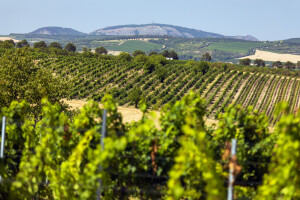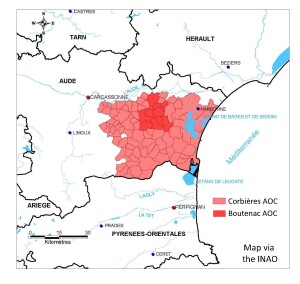 Newsflash from the Languedoc: The Corbières-Boutenac AOC has changed its name and will now be known as the Boutenac AOC. The wine producers of the Boutenac area submitted a proposal to change the name of the appellation back in September of 2022, and as of March 14, 2024, the EU has approved the modification.
Newsflash from the Languedoc: The Corbières-Boutenac AOC has changed its name and will now be known as the Boutenac AOC. The wine producers of the Boutenac area submitted a proposal to change the name of the appellation back in September of 2022, and as of March 14, 2024, the EU has approved the modification.
To understand the Boutenac region, we need to first look at the larger, surrounding Corbières AOC. For starters, Corbières is one of the largest appellations in the Languedoc (along with Minervois) in terms of overall size, vineyard plantings, and production volume. A prodigious producer of red (rogue), white (blanc) and rosé wine, Corbières was granted it initial AOC designation in 1985. Since that time, the appellation has been updated several times; many changes involved its elaborate list of allowed grape varieties and the composition thereof. Others broke the large region into a bit more geographic specificity, and in 2005, the Boutenac region was spun-off into its own AOC, originally known as the Corbières-Boutenac AOC.
The Boutenac area—centered around the tiny town of Boutenac and located atop an elevated ridge of limestone about 30 kilometers/20 miles inland from the Mediterranean coast—consists of well-drained, low-nutrient soils. As wine lovers know, when these two features combine, they can produce some of the finest vineyard terroirs—and wine grapes—in the world.
 As such, Boutenac has always enjoyed a reputation for high-quality wine. Additionally, it produces red wine only (as opposed to the extensive list of grapes and wine in play in the larger Corbières appellation). These factors are part of the ongoing efforts to seek out a separate identity for the Boutenac AOC apart from the larger Corbières appellation.
As such, Boutenac has always enjoyed a reputation for high-quality wine. Additionally, it produces red wine only (as opposed to the extensive list of grapes and wine in play in the larger Corbières appellation). These factors are part of the ongoing efforts to seek out a separate identity for the Boutenac AOC apart from the larger Corbières appellation.
- The red wines of the Boutenac AOC are produced under the following regulations:
- Dry, still (non-sparkling), red wines are the only wines allowed for production
- It must be comprised of a minimum of 70% (combined) Carignan, Grenache (Noir), Mourvèdre, and Syrah.
- In addition, Carignan must comprise a minimum of 30% of the blend, and no single variety may comprise more than 80% of the overall blend.
- The wine must be aged (at least) until December 31 of th year following harvest to include at least two months in the bottle.
The red wines of the Boutenac AOC are described (in the cahier des charges) as being powerful and generous on the palate and having a red deep color with violet highlights as well as notes of spice and mature fruit.
We can’t wait to try Boutenac AOC!
References/for more information:
Post authored by Jane A. Nickles…your blog administrator: jnickles@societyofwineeducators.org